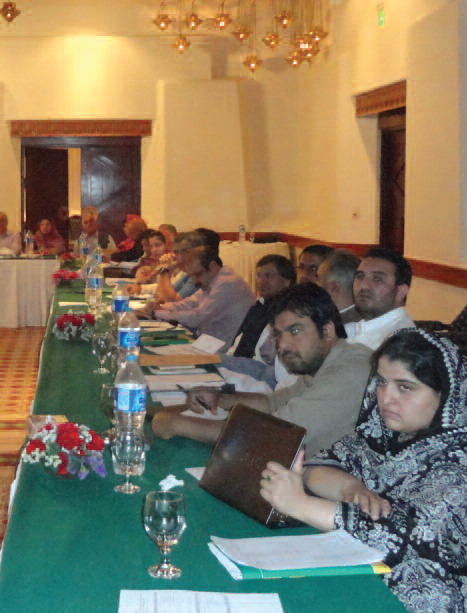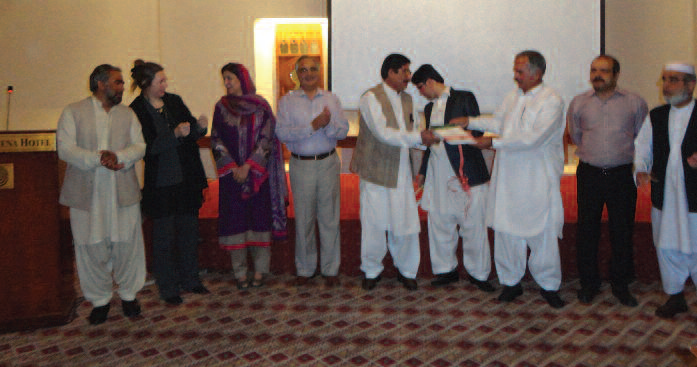Scaling up nutrition: experiences from Balochistan, Pakistan
 Muhammad Sheraz and Dr. Ali Nasir Bugti
Muhammad Sheraz and Dr. Ali Nasir Bugti
Muhammad Sheraz is the Nutrition Information Management Officer for the Department of Health within the Government of Balochistan.
Dr. Ali Nasir Bugti is the Provincial Coordinator for Nutrition for the Department of Health within the Government of Balochistan.
Balochistan is the most underdeveloped of four provinces of Pakistan and has a very poor health and nutrition situation. According to the 2011 National Nutrition Survey, the prevalence of stunting in Balochistan is 52.2 %, amongst the highest in the world. The prevalence of wasting is 16.1%, exceeding the WHO-threshold of 15%, indicating a public health emergency. Women and children also suffer from some of the world’s highest levels of vitamin and mineral deficiencies with maternal anemia at 47.3% and Vitamin A deficiency in children at 74%. Based on current trends, Balochistan is not on track to achieve the Millennium Development Goal of halving the 1990 level of undernutrition by 2015.
The Government of Balochistan and its partners recognise the implications of such high levels of undernutrition on economic and human development and as a result are now undertaking a multi-sectoral nutrition approach in line with the SUN Movement.
 The SUN Framework includes three main components:
The SUN Framework includes three main components:
- Evidence-based and cost-effective interventions to prevent and treat undernutrition, with highest priority to the minus 9 to 24 month window of opportunity, termed ‘the first 1000 days’
- A multi-sectoral approach that includes integrating nutrition in related sectors and using indicators of undernutrition as one of the key measures of overall progress in these sectors
- Substantially scaled up domestic and external assistance, through a coordinated development partner response, for country-owned nutrition programmes and capacities.
Pakistan, and Balochistan in particular, has made significant progress on this since 2010. In September 2011, the Economic Affairs Division of Pakistan took an important step when it called a meeting of development partners and donors currently engaged in and funding different projects in Pakistan (referred to as the D-10 Group) to discuss nutrition. During the meeting, the provinces committed to preparing multi-sectoral nutrition plans. Since then, Balochistan has:
- Developed a policy guidance document to assess provincial levels of undernutrition, identify sectoral programmes associated with reducing undernutrition, and to begin identifying possible roles for these sectors in a collective effort to reduce undernutrition in the province. The document also contains the list of benefits likely to accrue to each of the sectors from improved nutrition in the province.
- Finalised an Inter-Sectoral Nutrition strategy. This strategy seeks both to prevent and treat undernutrition directly (nutrition-specific interventions) and also addresses the determinants of undernutrition (nutrition-sensitive interventions.) The focus is on hygiene practices, access to safe water, sanitation and health services, household food security, access to a diversified diet, socioeconomic constraints and literacy.
For each sector the strategy includes a set of strategic objectives, outcomes, outputs, and activities with a plan for a coordinating entity to be lodged in the Provincial Department of Planning and Development. The strategy identifies a subset of indicators included in a ‘Results Monitoring Framework’. The ongoing monitoring and review of these indicators will provide the Province with a means of assessing progress of the strategy on an ongoing basis. Given the diversity and multi-sectoral causes of undernutrition, a separate unit focusing on planning and monitoring will be created and housed in the Planning and Development Department to maintain accountability for all key levels and observe overall progress. The strategy’s underlying approach will be to “plan multi sectorally, implement sectorally and then review multi sectorally”. The next stage will be to cost the plan. Currently the Planning and Development Department includes sections such as agriculture and health, but not nutrition. The Health Section is currently looking at nutrition with plans to establish a separate Nutrition Section to plan and monitor overall progress of the inter-sectoral strategy.
- Identified a Provincial Nutrition Steering Committee, chaired by the Additional Chief Secretary for Development, the second highest ranking official at the provincial level after the Chief Secretary. The department heads for health, agriculture and other relevant departments are members.
- Identified an Inter-sectoral Technical Working Group (TWG) under the Department of Planning and Development. Each sector will have a specific TWG and the Nutrition TWG and Steering Committee are now guiding the transformation of the Inter-Sectoral Nutrition strategy into an operational plan.
Nutrition and other sectors have been asked to prepare and cost their proposals, in line with the nutrition specific and sensitive interventions suggested by the multi-sectoral nutrition strategy for each sector. The steering committee and nutrition TWG aims to identify adequate resources to fund these through either government funds or donor funding. At the time of writing, only the Health Sector has costed their plan for a total of 14.92 million USD (1492 million Pak Rupees) over a three-year period (July 2014 to June 2017), which will target 7 high-risk districts (out of Balochistan’s 30 districts in total). Within this, the budget for community-based management of acute malnutrition (CMAM) and Infant and Young Child Feeding (IYCF) combined is 5.42 million USD. The health sector plan aims to:
- Increase access and availability of IYCF and CMAM services across the targeted districts for targeted populations (male and female children 0-5 years and pregnant and lactating women);
- Improve consumption of micronutrients through fortification and supplementation;
- Enhance level of knowledge and increase awareness of nutrition interventions among households who have children less than 5 years of age and pregnant/lactating women;
- Strengthen the nutrition programme within the health department; and
- Strengthen Monitoring and Evaluation Systems with the focus on generating information for evidence based planning and implementation.
Multi donor trust funds are available for the various interventions and the Department of Health of Balochistan is ready and prepared to implement once the project proposal is approved at national level.
 Expected challenges
Expected challenges
The multi-sectoral approach will require a high level of commitment, effective coordination, and informed leadership for its success. Some of the possible challenges facing Balochistan in effective implementation include:
- Accountability: The newly formed Nutrition Section within the Planning and Development Department will not have stated authority to hold other departments accountable to delivering on their nutrition related results. How other sectors will be made accountable to the nutrition section is still a big question mark and a key challenge ahead.
- Priority: Nutrition is not a common agenda for all sectors and thus the level of understanding and priorities within other sectors may vary.
- Resources: There may not be the necessary resources to make the nutrition strategy operational as donor funding for nutrition sensitive plans for other sectors other than health currently does not exist.
- Capacity: There is limited capacity within other sectors, particularly with regards to nutrition sensitive programming, that could limit their understanding on what human resource capacity is required to roll out nutrition sensitive interventions.
- Coordination: The province has no previous experience in inter-sectoral coordination for thematic programming.
For more information, please contact Muhammad Sheraz: Mohammad.sheraz@live.com

